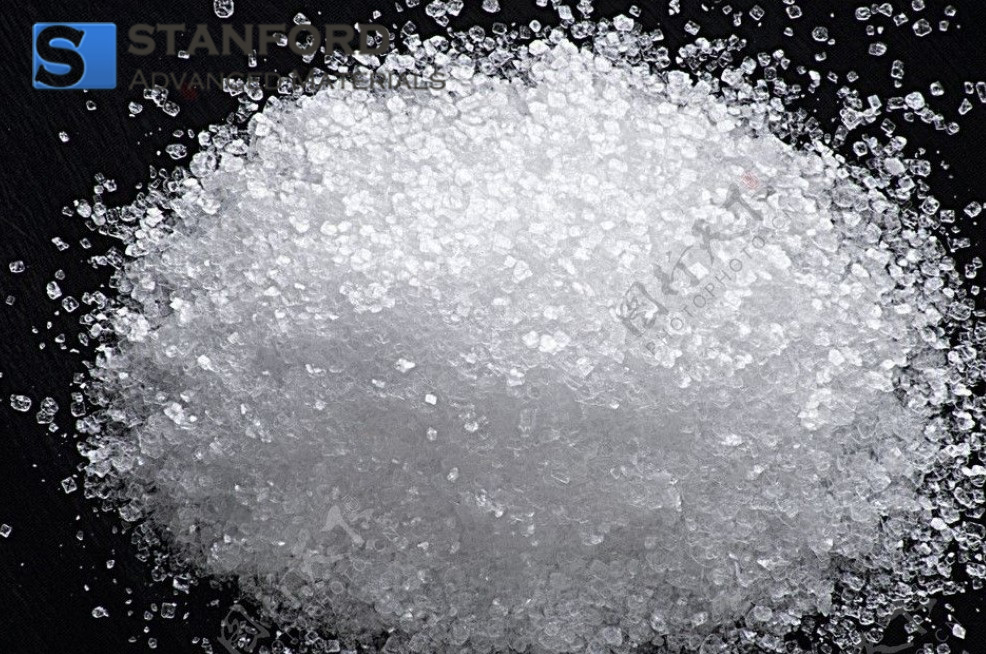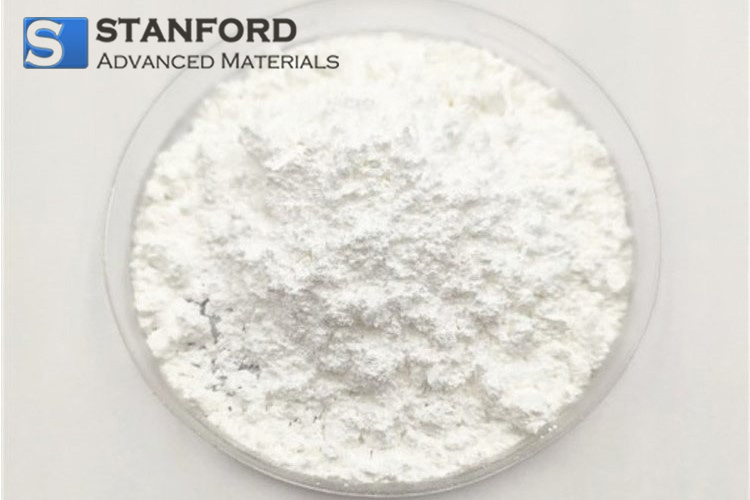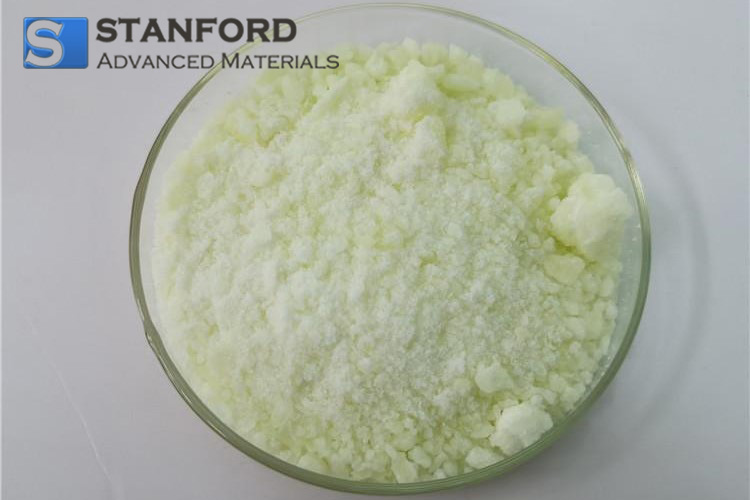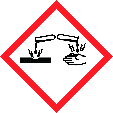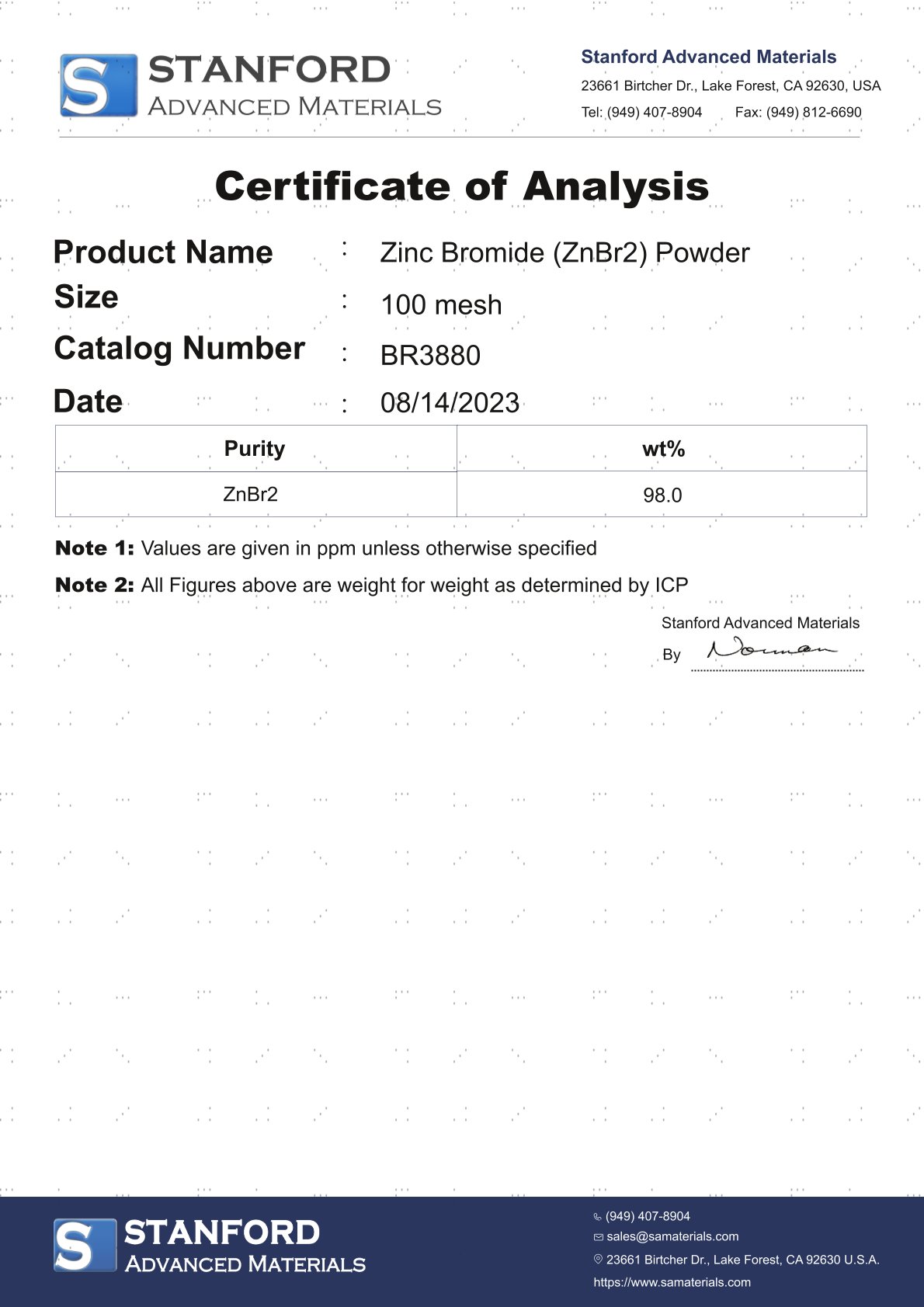SECTION 1. IDENTIFICATION
Product Name: Zinc Bromide
CAS #: 7699-45-8
Relevant identified uses of the substance: Scientific research and development
Supplier details:
Stanford Advanced Materials
E-mail: sales@samaterials.com
Tel: (949) 407-8904
Address: 23661 Birtcher Dr., Lake Forest, CA 92630 U.S.A.
SECTION 2. HAZARDS IDENTIFICATION
2.1 Classification of the substance or mixture
Classification according to Regulation (EC) No 1272/2008
GHS05 corrosion
Skin Corr. 1B H314 Causes severe skin burns and eye damage.
GHS09 environment
Aquatic Acute 1 H400 Very toxic to aquatic life.
Aquatic Chronic 1 H410 Very toxic to aquatic life with long lasting effects.
GHS07
Acute Tox. 4 H302 Harmful if swallowed.
Skin Sens. 1 H317 May cause an allergic skin reaction. Other hazards that do not result in
classification No information known.
2.2 Label elements
Labelling according to Regulation (EC) No 1272/2008 The substance is classified and labelled
according to the CLP regulation. Hazard pictograms
GHS05 GHS07 GHS09
Signal wordDanger
Hazard statements
H302 Harmful if swallowed.
H314 Causes severe skin burns and eye damage.
H317 May cause an allergic skin reaction.
H410 Very toxic to aquatic life with long lasting effects.
Precautionary statements
P260 Do not breathe dusts or mists.
P303+P361+P353 IF ON SKIN (or hair): Take off immediately all contaminated clothing. Rinse skin
with water/shower. P305+P351+P338 IF IN EYES: Rinse cautiously with water for several minutes.
Remove contact lenses, if present and easy to do. Continue rinsing. P301+P330+P331 IF
SWALLOWED: rinse mouth. Do NOT induce vomiting. P405 Store locked up.
P501 Dispose of contents/container in accordance with local/regional/national/international
regulations. 2.3 Other hazards
Results of PBT and vPvB assessment
PBT: Not applicable.
vPvB: Not applicable
SECTION 3. COMPOSITION/INFORMATION ON INGREDIENTS
Substances
CAS# Designation:
7699-45-8 Zinc bromide
Concentration: ≤100%
Identification number(s):
EC number: 231-718-4
SECTION 4. FIRST AID MEASURES
4.1 Description of first aid measures
General information Instantly remove any clothing soiled by the product. After inhalation
Supply fresh air. If required, provide artificial respiration. Keep patient warm. Consult doctor if
symptoms persist. Seek immediate medical advice.
After skin contact
Instantly wash with water and soap and rinse thoroughly.
Seek immediate medical advice.
After eye contact Rinse opened eye for several minutes under running water. Then consult doctor.
After swallowing Seek medical treatment.
4.2 Most important symptoms and effects, both acute and delayed
Causes severe skin burns.
Harmful if swallowed.
May cause an allergic skin reaction.
4.3 Indication of any immediate medical attention and special treatment needed No further relevant
information available
SECTION 5. FIREFIGHTING MEASURES
5.1 Extinguishing media
Suitable extinguishing agents Product is not flammable. Use fire-fighting measures that suit the
surrounding fire. 5.2 Special hazards arising from the substance or mixtureIf this product is involved in a fire, the following can be released: Hydrogen bromide (HBr)
Zinc oxide
5.3 Advice for firefighters
Protective equipment:
Wear self-contained breathing apparatus.
Wear full protective suit.
SECTION 6. ACCIDENTAL RELEASE MEASURES
6.1 Personal precautions, protective equipment and emergency procedures
Wear protective equipment. Keep unprotected persons away. Ensure adequate ventilation
6.2 Environmental precautions: Do not allow product to reach sewage system or water bodies. 6.3
Methods and material for containment and cleaning up:
Use neutralising agent.
Dispose of contaminated material as waste according to section 13. Ensure adequate ventilation.
Prevention of secondary hazards: No special measures required. 6.4 Reference to other sections
See Section 7 for information on safe handling
See section 8 for information on personal protection equipment. See Section 13 for information on
disposal.
SECTION 7. HANDLING AND STORAGE
7.1 Precautions for safe handling
Handle under dry protective gas.
Keep containers tightly sealed.
Store in cool, dry place in tightly closed containers. Ensure good ventilation/exhaustion at the
workplace.
Information about protection against explosions and fires: The product is not flammable
7.2 Conditions for safe storage, including any incompatibilities
Storage
Requirements to be met by storerooms and containers: No special requirements. Information about
storage in one common storage facility:
Store away from water.
Store away from strong bases.
Store away from oxidising agents.
Further information about storage conditions:
Store under dry inert gas.
This product is hygroscopic.
Keep container tightly sealed.
Store in cool, dry conditions in well sealed containers.
Protect from humidity and keep away from water.
Store in a locked cabinet or with access restricted to technical experts or their assistants. 7.3 Specific
end use(s) No further relevant information available.
SECTION 8. EXPOSURE CONTROLS/PERSONAL PROTECTION
Additional information about design of technical systems:
Properly operating chemical fume hood designed for hazardous chemicals and having an average
face velocity of at least 100 feet per minute.
8.1 Control parametersComponents with critical values that require monitoring at the workplace:
7699-45-8 Zinc bromide (100,0%)
MAK (Germany) Long-term value: 0,1A* 2E** mg/m³ *alveolengängig; **einatembar
Additional information: No data
8.2 Exposure controls
Personal protective equipment
General protective and hygienic measures
The usual precautionary measures should be adhered to in handling the chemicals. Keep away from
foodstuffs, beverages and food.
Instantly remove any soiled and impregnated garments.
Wash hands during breaks and at the end of the work.
Avoid contact with the eyes and skin.
Maintain an ergonomically appropriate working environment.
Breathing equipment: Use breathing protection with high concentrations. Recommended filter device
for short term use:
Use a respirator with type P100 (USA) or P3 (EN 143) cartridges as a backup to engineering controls.
Risk assessment should be performed to determine if air-purifying respirators are appropriate. Only
use equipment tested and approved under appropriate government standards. Protection of hands:
Check protective gloves prior to each use for their proper condition. The selection of the suitable
gloves does not only depend on the material, but also on further marks of quality and varies from
manufacturer to manufacturer.
Material of gloves Nitrile rubber, NBR
Penetration time of glove material (in minutes) 480
Glove thickness: 0.11 mm
Eye protection:
Tightly sealed safety glasses.
Full face protection
Safety glasses with side shields / NIOSH (US) or EN 166(EU)
Body protection: Protective work clothing.
SECTION 9. PHYSICAL AND CHEMICAL PROPERTIES
9.1 Information on basic physical and chemical properties
General Information
Appearance:
Form: Powder/crystalline/beads Odour: Not determined
Odour threshold: Not determined.
pH-value: Not applicable.
Change in condition
Melting point/freezing point: 394 °C
Initial boiling point and boiling range: 650 °C
Sublimation temperature / start: Not determined
Inflammability (solid, gaseous) Not determined.
Ignition temperature: Not determined
Decomposition temperature: Not determined
Self-inflammability: Not determined.
Explosive properties: Not determined.
Critical values for explosion:
Lower: Not determined
Upper: Not determined
Steam pressure: Not applicable. Density at 20 °C 4,201 g/cm³ Relative density Not determined.
Vapour density Not applicable.
Evaporation rate Not applicable. Solubility in / Miscibility withWater at 20 °C: 4470 g/l Partition coefficient: n-octanol/water: Not determined.
Viscosity:
dynamic: Not applicable.
kinematic: Not applicable. 9.2 Other information No further relevant information available.
SECTION 10. STABILITY AND REACTIVITY
10.1 Reactivity No information known.
10.2 Chemical stability Stable under recommended storage conditions. Thermal decomposition /
conditions to be avoided: No decomposition if used and stored according to specifications. 10.3
Possibility of hazardous reactions Reacts with strong oxidising agents 10.4 Conditions to avoid No
further relevant information available.
10.5 Incompatible materials:
Bases
Oxidising agents
Water/moisture
10.6 Hazardous decomposition products:
Hydrogen bromide
Zinc oxide
SECTION 11. TOXICOLOGICAL INFORMATION
11.1 Information on toxicological effects
Acute toxicity
Harmful if swallowed.
Swallowing will lead to a strong caustic effect on mouth and throat and to the danger of perforation of
esophagus and stomach. Harmful if swallowed.
LD/LC50 values that are relevant for classification: No data
Skin irritation or corrosion:
Causes severe skin burns.
Causes severe skin burns and eye damage.
Eye irritation or corrosion:
Causes serious eye damage.
Causes severe skin burns and eye damage.
Respiratory or skin sensitisation
May cause an allergic skin reaction.
Germ cell mutagenicity: The Registry of Toxic Effects of Chemical Substances (RTECS) contains
mutation data for this substance.
Carcinogenicity: No classification data on carcinogenic properties of this material is available from the
EPA, IARC, NTP, OSHA or ACGIH.
Reproductive toxicity: No effects known.
Specific target organ system toxicity - repeated exposure: No effects known.
Specific target organ system toxicity - single exposure: No effects known.
Aspiration hazard: No effects known.
Subacute to chronic toxicity: No effects known.
Additional toxicological information: To the best of our knowledge the acute and chronic toxicity of this
substance is not fully known.
SECTION 12. ECOLOGICAL INFORMATION
12.1 Toxicity
Aquatic toxicity: No further relevant information available.
12.2 Persistence and degradability No further relevant information available.
12.3 Bioaccumulative potential No further relevant information available.
12.4 Mobility in soil No further relevant information available.
Ecotoxical effects:
Remark: Very toxic for fish Additional ecological information:
General notes:
Water danger class 3 (Self-assessment): extremely hazardous for water.
Do not allow product to reach ground water, water bodies or sewage system, even in small quantities.
Danger to drinking water if even extremely small quantities leak into soil. Also poisonous for fish and
plankton in water bodies. May cause long lasting harmful effects to aquatic life.
Avoid transfer into the environment.
Very toxic for aquatic organisms
12.5 Results of PBT and vPvB assessment
PBT: Not applicable.
vPvB: Not applicable
12.6 Other adverse effects No further relevant information available
SECTION 13. DISPOSAL CONSIDERATIONS
13.1 Waste treatment methods
Recommendation
Hand over to disposers of hazardous waste.
Must be specially treated under adherence to official regulations. Consult state, local or national
regulations for proper disposal.
Uncleaned packagings:
Recommendation: Disposal must be made according to official regulations.
SECTION 14. TRANSPORT INFORMATION
UN-Number
ADR, IMDG, IATA UN3260
14.2 UN proper shipping name
ADR 3260 CORROSIVE SOLID, ACIDIC, INORGANIC, N.O.S. (Zinc bromide) IMDG CORROSIVE
SOLID, ACIDIC, INORGANIC, N.O.S. (Zinc bromide), MARINE POLLUTANT
IATA CORROSIVE SOLID, ACIDIC, INORGANIC, N.O.S. (Zinc bromide)
14.3 Transport hazard class(es)
ADR
Class 8 (C2) Corrosive substances. Label 8
IMDG
Class 8 Corrosive substances.
Label 8
IATA
Class 8 Corrosive substances.
Label 8
Packing group
ADR, IMDG, IATA II
14.5 Environmental hazards: Environmentally hazardous substance, solid; Marine Pollutant Marine
pollutant: Symbol (fish and tree)14.6 Special precautions for user Warning: Corrosive substances. Kemler Number: 80
EMS Number: F-A,S-B
Segregation groups Acids
Stowage Category B
14.7 Transport in bulk according to Annex II of Marpol and the IBC Code Not applicable.
Transport/Additional information:
ADR
Limited quantities (LQ) 1 kg Excepted quantities (EQ) Code: E2
Maximum net quantity per inner packaging: 30 g
Maximum net quantity per outer packaging: 500 g Transport category 2
Tunnel restriction code E
IMDG
Limited quantities (LQ) 1 kg Excepted quantities (EQ) Code: E2
Maximum net quantity per inner packaging: 30 g
Maximum net quantity per outer packaging: 500 g
UN "Model Regulation": UN 3260 CORROSIVE SOLID, ACIDIC, INORGANIC, N.O.S. (ZINC
BROMIDE),
8, II
SECTION 15. REGULATORY INFORMATION
15.1 Safety, health and environmental regulations/legislation specific for the substance or mixture
Australian Inventory of Chemical Substances Substance is listed.
Standard for the Uniform Scheduling of Medicines and Poisons Substance is not listed.
Directive 2012/18/EU
Named dangerous substances - ANNEX I Substance is not listed.
Seveso category E1 Hazardous to the Aquatic Environment Qualifying quantity (tonnes) for the
application of lower-tier requirements 100 t
Qualifying quantity (tonnes) for the application of upper-tier requirements 200 t
National regulations
Information about limitation of use:
Employment restrictions concerning young persons must be observed. For use only by technically
qualified individuals.
Classification according to VbF: Not applicable
Water hazard class: Water danger class 3 (Self-assessment): extremely hazardous for water. Other
regulations, limitations and prohibitive regulations
ELINCS (European List of Notified Chemical Substances) Substance is not listed.
Substance of Very High Concern (SVHC) according to the REACH Regulations (EC) No. 1907/2006.
Substance is not listed.
The conditions of restrictions according to Article 67 and Annex XVII of the Regulation (EC) No
1907/2006 (REACH) for the manufacturing, placing on the market and use must be observed.
Substance is not listed.
Annex XIV of the REACH Regulations (requiring Authorization for use) Substance is not listed
15.2 Chemical safety assessment: A Chemical Safety Assessment has not been carried out.
SECTION 16. OTHER INFORMATION
Safety Data Sheet according to Regulation (EC) No. 1907/2006 (REACH). The above information is
believed to be correct but does not purport to be all inclusive and shall be used only as a guide. The
information in this document is based on the present state of our knowledge and is applicable to the
product with regard to appropriate safety precautions. It does not represent any guarantee of theproperties of the product.
